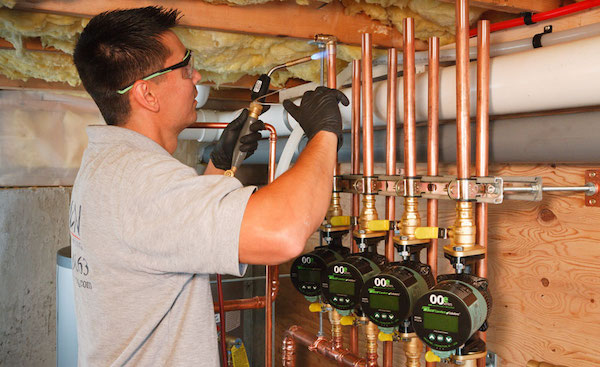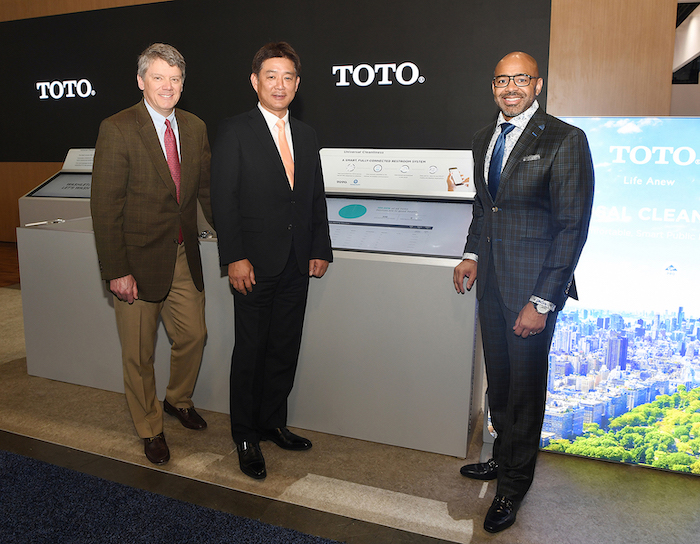It doesn’t seem so long ago we were fending off the “green” movement that was being force-fed into the vocab of working contractors. From green building to green technology, greenwashing was so prevalent that really the only “green” contractors were concerned with was the one they were chasing every day—a profit. But alas, a new Read more
Internet of Things

It doesn’t seem so long ago we were fending off the “green” movement that was being force-fed into the vocab of working contractors. From green building to green technology, greenwashing was so prevalent that really the only “green” contractors were concerned with was the one they were chasing every day—a profit.
But alas, a new word has dominated the marketing lexicon—“smart.” Smart cars, smart phones, smart homes and yes, even smart pumps. “The problem is they’re not that smart,” says John Barba, contractor training manager, Taco Comfort Systems. “I’ve heard people who you’d think would know better say idiotic stuff like ‘these pumps do the thinking for you,’ and ‘they take the thinking out of it,’” says Barba.

Image Credit: Noven; Bethesda.net
How about giving credit to the users who actually interact with such devices? “The thing that separates the professional from the DIY’er or the handyman is his or her ability to think and their understanding of systems. That’s why people hire professionals, and that’s why our profession is so valuable. When it comes to systems and components, the professional is the smart one,” says Barba
“The professional knows what he’s holding in his hands, why he’s using it and what impact it’s going to have on the overall system performance. There’s not a pump made that can replace what the pro knows. The machines haven’t taken over yet,” continues Barba.
Intelligent Systems
If the integration or connectivity of disparate components to a holistic, communicative system is considered smart, then I’m buying in. Why not just say that in the first place? Because it’s not market-y, and it’s too long for a tagline. Okay, then the evolution of homebuilding can be categorized as being smart or intelligent because the integration of, say, lighting, security, home entertainment, etc., can be accessed from the convenience of your smart phone (more on that later). But I’d say that is more a matter or convenience than smarts.
In fact, as part of these communicative devices, perhaps on a broader, commercial stage, we are witnessing new phrases popping up such as the Internet of Things (IoT). According to Sokwoo Rhee, former associate director of the Cyber-Physical Systems Program at the National Institute of Standards and Technology (NIST) from 2014 to 2021, IoT can be described as the advancements in sensors and communication technologies that enable us to collect data which was not previously practical; the explosive increase of the amount of collected data enabled us to perform analytics which was not previously practical or meaningful; and the advancements in data analytics that will enable us to better control and optimize the systems to benefit our daily life. Again, I can buy into that.
Remember when cell phones were labeled smart phones? I think they still are. It’s 2007 and my fancy handheld device can make calls and perform functions as a computer. Well guess what? Today, they are just considered phones. And, if they don’t perform almost any function you can think of, well, then perhaps they are just dumb.
And, oh yeah, what makes a smart car? Good gas mileage? Actually, the term Smart Car came from a venture between watchmaker Swatch and Mercedes-Benz, with Smart standing for Swatch Mercedes Art, a branding stroke of genius. Its small stature was designed for city driving with big gas savings and easy maneuverability, with not-so-good safety ratings, I’d imagine. Debuting in the U.S. in 2008, last I read, it was discontinued in 2019.
And back to those smart, magical pumps? “The only word I hate more than ‘smart’ is ‘magic,’” says Barba. “Anyone who says something like that really doesn’t know how ECM circulators really work, or how they interact with systems. No matter how ‘smart’ people claim these things are, you can’t get away from the fundamentals of circulators. These things have performance—or ‘control’ curves—and the system still has a system curve,” says Barba.

According to Barba, there’s no such thing as magic, and the only circulator that can even come remotely close to sizing itself is the Taco VT2218—it’s a Delta-T circulator and varies its speed to maintain a fixed delta-T in the system.
“And I don’t care how many lights and buttons you put on the circulator, you can’t change the fact that when you have a fixed performance curve—as every Delta-P variable speed circulator has—the system has to work where the system curve intersects the control curve. If it’s a zone valve system, speed and flow will change as zone valves open and close, but it still works on the selected control curve. If it’s a zone pump system, a Delta-P circulator won’t vary its speed because there’s nothing in a zone that would create a change in pressure differential. It goes one speed and that’s it. That’s not what I’d call smart.
“Now, that doesn’t mean you shouldn’t use a Delta-P pump as a zone pump. You should—it’ll do some pretty cool things for you provided it’s set up properly. And for that, you need a smart installer who understands what these circulators do, what they don’t do and how they interact with the system,” says Barba.
“Just because a circulator is variable speed, that doesn’t make it magic. This isn’t Hogwarts and you’re not Harry-freaking-Potter.”
What’s my point in all of this? Dig deeper, educate yourself, rely on your experience and knowledge, and don’t rely on marketing taglines such as Smart or Green to sell you completely on something.

TOTO announced that Hartsfield-Jackson Atlanta International Airport, the world’s busiest airport with more than 107 million annual passengers, is the first facility in the world to offer the Smart, Fully-Connected Restroom System. Thanks to a collaboration by TOTO and GP PRO, the airport is now testing the tools and connected products it needs to help Read more
TOTO announced that Hartsfield-Jackson Atlanta International Airport, the world’s busiest airport with more than 107 million annual passengers, is the first facility in the world to offer the Smart, Fully-Connected Restroom System. Thanks to a collaboration by TOTO and GP PRO, the airport is now testing the tools and connected products it needs to help ensure its busiest restrooms are always clean, comfortable, and fully operational.

(l to r) Mike Slawson, Vp of connected devices for GP PRO, Shinya Tamura, CEO of TOTO USA and Dr. Kofi Smith, president and CEO of Atlanta Airport Terminal Company, discuss Hartsfield-Jackson Atlanta International Airport’s significant improvements in sustainability, labor efficiency and restroom operation costs as a result of its new Smart, Fully-Connected Restroom System, thanks to a collaboration between TOTO and GP PRO.
“For more than 100 years, TOTO has improved people’s bathroom experience with revolutionary products and technologies that provide a consistently clean, comfortable experience,” said Shinya Tamura, CEO of TOTO USA. “As we confidently embark on our next 100-year cycle, we will continue our pioneering work by expanding our core competencies through collaborations with leading-edge companies, like GP PRO, whose inventive technologies and innovative business models redefine the commercial restroom experience.”
Public Restroom of the Future Takes Flight
To help ensure its passengers enjoy a clean, comfortable restroom experience every time, Hartsfield-Jackson has installed TOTO and GP PRO’s smart, fully-connected restroom solution. Leveraging the Internet of Things, the award-winning KOLO™ Smart Monitoring System uses wireless communication technologies, cloud-based processing and data storage, and cutting-edge sensors and sensing technology to provide timely, customized and secure communication between connected restroom fixtures and facility managers and their custodial staff through smartphone, tablet, and desktop apps.
Installed on TOTO’s EcoPower® flush valves and faucets and GP PRO’s enMotion® and Compact® paper towel, toilet tissue and sanitizer dispensers in the busiest restrooms (B Concourse) at Hartsfield-Jackson, the technology monitors product usage, jams, outages, and leaks, alerting the airport’s custodial staff in real-time so that problems are addressed immediately — long before weary passengers encounter them.
For Hartsfield-Jackson, a bad restroom experience can affect its bottom line. A JD Powers’ study (2015) found that for large airports (at least 30 million passengers per year), “delighted” passengers spend up to 190% more in the airport than disappointed ones. Since the Atlanta Airlines Terminal Company (AATC) installed the KOLO Smart Monitoring System and connected products by TOTO and GP PRO in Concourse B, its busiest restrooms, the AATC has enjoyed improved sustainability, increased labor efficiency, and increased costs savings in restroom operation. Further, the AATC has seen an increase in custodians’ job satisfaction and has reduced waste.
“At Hartsfield-Jackson, we strive to provide our passengers with a world-class experience — one that truly delights them. Not simply because it improves our bottom line, but also because it has a positive impact on their perception of our airport and our city as a whole,” said Dr. Kofi Smith, President and CEO of the AATC. “In the past, our public restrooms were a major source of passenger frustration and complaint. However, since we installed the KOLO Smart Monitoring System in B Concourse — our busiest restrooms — we have elevated our passengers’ experience and seen a significant positive impact on our custodial staff and bottom line. It’s truly transformative technology.”
In the future, TOTO believes that consumers will be able to experience clean, comfortable public restrooms wherever they travel for work and play—airports, restaurants, office buildings, train stations, hospitals, retail spaces, and stadiums. The smart, fully-connected restroom solution comprised of the KOLO Smart Monitoring System and connected products by TOTO and GP PRO is customizable and a smart investment for small, medium or large facilities.
“Our KOLO Smart Monitoring System provides consistent tracking and monitoring across a site’s entire restroom environment, be it a single building or a multi-building campus,” said Mike Slawson, Vice President of Connected Devices for GP PRO. “It offers benefits that help meet the facilities’ critical needs, including improved sustainability, improved labor efficiency, and increased cost savings in restroom operation.”
By remotely monitoring and analyzing restroom conditions and responding in real-time to potential problems, the KOLO Smart Monitoring System helps maintenance and custodial teams ensure that the right staff are performing the right tasks at the right time, and consumers enjoy a clean, comfortable experience every time.
